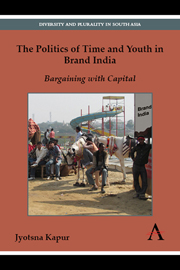Book contents
- Frontmatter
- Dedication
- Contents
- Acknowledgments
- Introduction: After Me the Flood
- Chapter 1 Brand India's Biggest Sale: The Cultural Politics and Political Economy of India's “Global Generation”
- Chapter 2 Arrested Development and the Making of a Neoliberal State
- Chapter 3 For Some Dreams a Lifetime is Not Enough: The Rasa Aesthetic and the Everyday in Neoliberalism
- Chapter 4 An “Arranged Love” Marriage: India's Neoliberal Turn and the Bollywood Wedding Culture Industry
- Chapter 5 Ek Haseenah Thi (There Once Was a Maiden): The Vanishing Middle Class and Other Neoliberal Thrills
- Conclusion
- Notes
- References
- Index
- Frontmatter
- Dedication
- Contents
- Acknowledgments
- Introduction: After Me the Flood
- Chapter 1 Brand India's Biggest Sale: The Cultural Politics and Political Economy of India's “Global Generation”
- Chapter 2 Arrested Development and the Making of a Neoliberal State
- Chapter 3 For Some Dreams a Lifetime is Not Enough: The Rasa Aesthetic and the Everyday in Neoliberalism
- Chapter 4 An “Arranged Love” Marriage: India's Neoliberal Turn and the Bollywood Wedding Culture Industry
- Chapter 5 Ek Haseenah Thi (There Once Was a Maiden): The Vanishing Middle Class and Other Neoliberal Thrills
- Conclusion
- Notes
- References
- Index
Summary
If there is a limit to all things and a measure
and a last time and nothing more and forgetfulness,
who will tell us to whom in this house
we without knowing it have said farewell
—Limits, Jorge Luis BorgesThe beauty and pain of human life stems from our ability to exist between two poles — the actual and the virtual or imaginative. On one end are the constraints, experienced directly and sensuously in both space and time — one's location in place, the mortality of the human body and the social relations of the world we are born into. On the other end is the horizon of freedom opened by the imagination which makes it possible for us to transcend our location in time and space. Yi-Fu Tuan (1977), counter-posing space to place, explains that we live in both the actual and the virtual simultaneously. Place offers us security while space is the site of possibility, of elsewhere. We are attached, Tuan notes, to the former and long for the latter — the former constrains us while the latter may threaten us. In terms of time-consciousness, following Bergson, we understand that humans cannot, like the hands of a clock, be confined to single moments in time that lead mathematically, one into the next. Rather, we defy the pure clock with memory and history, desire and anticipation. Human life is lived in duration and not as “scattered shreds of time” — Marx's characterization of labor under the regime of capital ([1867] 1976, 403).
- Type
- Chapter
- Information
- The Politics of Time and Youth in Brand IndiaBargaining with Capital, pp. 121 - 126Publisher: Anthem PressPrint publication year: 2013



